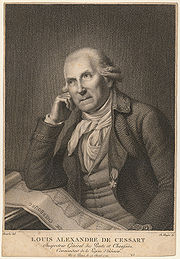
Louis-Alexandre de Cessart
Encyclopedia

Paris
Paris is the capital and largest city in France, situated on the river Seine, in northern France, at the heart of the Île-de-France region...
– 12 April 1806, Rouen
Rouen
Rouen , in northern France on the River Seine, is the capital of the Haute-Normandie region and the historic capital city of Normandy. Once one of the largest and most prosperous cities of medieval Europe , it was the seat of the Exchequer of Normandy in the Middle Ages...
) was a French road and bridge engineer.
He served in the "gendarmerie
Gendarme (historical)
A gendarme was a heavy cavalryman of noble birth, primarily serving in the French army from the Late Medieval to the Early Modern periods of European History...
de la Maison du Roi
Maison du Roi
The Maison du Roi was the name of the military, domestic and religious entourage around the royal family in France during the Ancien Régime and Bourbon Restoration; the exact composition and duties of its various divisions changed constantly over the Early Modern period...
", fighting at the battles of Fontenoy
Battle of Fontenoy
The Battle of Fontenoy, 11 May 1745, was a major engagement of the War of the Austrian Succession, fought between the forces of the Pragmatic Allies – comprising mainly Dutch, British, and Hanoverian troops under the nominal command of the Duke of Cumberland – and a French army under Maurice de...
and Raucoux in 1745 and 1746. In 1747 he entered the school of Jean-Rodolphe Perronet
Jean-Rodolphe Perronet
Jean-Rodolphe Perronet 27 October 1708, Suresnes – 27 February 1794, Paris) was a French architect and structural engineer, known for his many stone arch bridges. His best known work is the Pont de la Concorde .-Life and career:...
, which later became the École nationale des ponts et chaussées
École Nationale des Ponts et Chaussées
Founded in 1747, the École nationale des ponts et chaussées , often referred to as les Ponts, is the world's oldest civil engineering school...
. He contributed to the Encyclopédie with Perronet and Jean-Baptiste de Voglie
Jean-Baptiste de Voglie
Jean-Baptiste de Voglie , born Jean Bentivoglio was an eminent Italian road and bridge engineer.-Career:Descended from the Ferrara branch of the Bentivoglio, Jean de Voglie entered the Corps of Bridges and Roads in France in 1742 and was appointed under-engineer to Jean-Rodolphe Perronet at...
. He was made under-engineer of the generality of Tours
Tours
Tours is a city in central France, the capital of the Indre-et-Loire department.It is located on the lower reaches of the river Loire, between Orléans and the Atlantic coast. Touraine, the region around Tours, is known for its wines, the alleged perfection of its local spoken French, and for the...
in 1751.
Notably, it was he who conceived several bridges over the River Loire, along with the Pont des Arts
Pont des Arts
The Pont des Arts or Passerelle des Arts is a pedestrian bridge in Paris which crosses the Seine River. It links the Institut de France and the central square of the palais du Louvre, .-History:Between 1802 and 1804, a nine-arch metallic bridge for pedestrians was constructed at the location of...
over the Seine in Paris
Paris
Paris is the capital and largest city in France, situated on the river Seine, in northern France, at the heart of the Île-de-France region...
, the first dike project at Cherbourg, and several quays at ports in north-west France.

